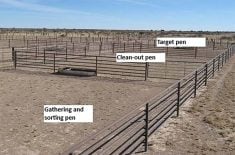The head of a horse contains a shockingly small brain. There is far more space dedicated to teeth, a muscular tongue, long nasal passages and the sinuses. The massive, complex sinuses in horses are prone to disease.
Sinuses are like a series of interconnected caves that occupy the front and sides of the face in the region of the eye socket. These have openings into the nasal cavity to allow air to pass between them.
Horses have three sinuses on each side of their heads. The reason is unknown but since they have tremendous athletic abilities, scientists suspect modifications to their head may be critical to cool the blood to the brain during extreme exercise.
Read Also

Beef cattle more prone to trace mineral deficiencies
The trace mineral status of our cows and calves is a significant challenge for western Canadian producers and veterinarians.
Of all the domestic animal species, horses are most prone to diseases of the sinuses. This is because their sinus chambers are intricate, they have poor drainage and they contain the roots of some cheek teeth.
Horses, particularly young ones, are prone to the equivalent of the common cold — viral upper respiratory tract infections. These nasal cavity infections result in soft tissue swelling. If the swelling becomes severe, it can block normal openings to the sinuses. Fluid and exudate accumulate because they are unable to drain.
The built-up fluid predisposes the area to infection and inflammation, and is called sinusitis.
Infections can be caused by a range of bacterial and fungal pathogens that can readily proliferate, leading to severe infection. Infection creates pus, which can become thick and trapped in the sinus.
Sinuses can also become infected via the cheek teeth. Horses have six cheek teeth on each side; three of these are premolars and three are molars. Depending on age of the horse, the roots of two or more cheek teeth are embedded directly in the sinus.
Horses have continually erupting teeth. As the crown wears down with normal chewing, more tooth emerges. Long roots that extend high up into the skull bones (upper teeth) and deep into the jaw bones (bottom teeth) are the result.
Infection of one or more of these cheek teeth can easily extend into the sinus that houses its root.
A few rare sinus diseases are also worth mentioning. These include masses such as cysts, tumours of various types and growths of clotted blood.
Clinical signs of sinus infection can include opaque discharge from one nostril, tears leaking abnormally from one eye and noisy breathing (on the in-breath). If there is a sinus mass, swelling on one side of the face may occur as the mass pushes the bones of the skull outward.
Diagnosis and treatment of sinus infections may involve the use of an endoscope, a long, narrow tube with a camera on the end.
The veterinarian can pass a scope into the nose to examine the sinus openings. Vets can also create a small hole into the sinus (called trepanation) to pass the endoscope directly into the sinus. The hole can then be used to collect a fluid sample for assessing inflammatory cells and culture them for microscopic organisms.
Vets can place a tube into the trephine hole to further assist treatment, including flushing, draining and administration of antibiotics.
Horses can also be treated with non-steroidal anti-inflammatory medications such as bute to reduce pain and inflammation. They can usually stand up for this procedure with sedation and local freezing.
In cases where the sinusitis is the result of an infected tooth, the tooth usually needs to be removed for the infection to clear. Similar treatment as for other sinus infections may be needed.
For cases that are complex or don’t respond well, surgery involving bone flaps to access the sinuses may be necessary.
It is worth exploring the possibility of sinus disease in a horse with one-sided nasal or eye discharge, if it has any facial swelling or if it just doesn’t seem to be recovering from a routine upper respiratory infection.
Dr. Jamie Rothenburger, DVM, MVetSc, PhD, DACVP, is a veterinarian who practices pathology and is an assistant professor at the University of Calgary’s Faculty of Veterinary Medicine. X: @JRothenburger















